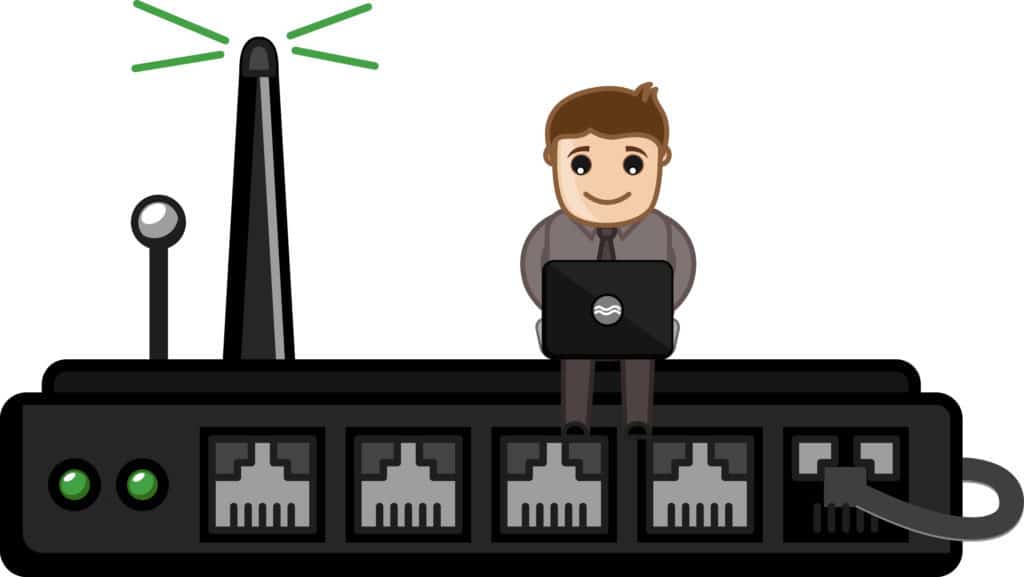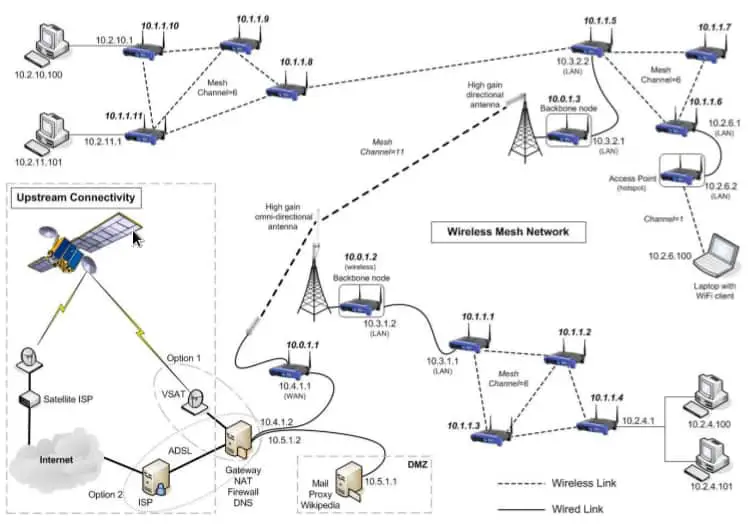The only network connectivity device that is capable of self-healing is the well renowned “Mesh Wi-Fi Router”. This is the reason more and more smart homes are now adapting the mesh technology for their connectivity and are quite happy with their performance. Since nearly everything in your home can be controlled through an automated system, a mesh router plays a vital role into making sure that this connectivity remains “UP” at all times and in the best and the securest ways possible. Care to know why I have chosen to use a Mesh Wi-Fi router for my own smart home setup? Then keep on reading.
Why are mesh Wi-Fi Router ideal for a smart home? The sole reason is that they do not rely on just one gateway to provide connectivity and thus gives the clients connected to its plethora of routes to the router ensuring there is no downtime. Due to its network structure and composition and most importantly its self-healing characteristics, this is the most preferred Wi-Fi router for all the smart homeowners across the globe.
Wi-Fi coverage is undoubtedly one of the most important factors when designing the smart home, since not one but almost all the IoT devices rely entirely on the connectivity. Bad Wi-Fi is not only a source of frustration for the user, but it could also pose a significant risk and threat if the smart security system that is connected to it, loses its connection. Forget about not being able to stream YouTube or Netflix, but the latter discussed is a deal that no one would want to take on! The technologists had been continuously trying to adapt to these latest trends of IoT automation and quite frankly have done an excellent job by introducing the Mesh Wi-Fi network routers. In this article, I would explain to you what made me buy the mesh Wi-Fi router and what the benefits it brings onto the table are. Is it costly? A bit yes, but it’s worth the investment. Connectivity is the first and the foremost thing one should look into before hopping on to the internet and start shelling out money on IoT devices to automate their home.
Table of Contents
What Is A Mesh Network That Everybody Keeps Talking About?

A mesh network works and functions differently than your traditional Wi-Fi network. This type of network provides a layer of reliability, meaning your smart home will always remain active and no matter what happens; the connectivity to the Wi-Fi router will not be impacted. How do mesh network functions? Let us dig into that!
A mesh network primarily consists of three parts
- Gateway
- Router
- Client
Gateway
A gateway is essentially the heart of the router. It is basically a device that takes the internet connectivity cable provided by your ISP (Internet Service Provider) and connect it directly into the modem/router, giving you access to use the internet.
Router
The gateway, as discussed above, is the backbone of internet connectivity. Once you have ensured that the ISP’s provided internet cable has been connected to it and you now have a “green” signal on your device (modem) confirming that the internet is up, now is the time to deploy routers. A router, simply put, are Wi-Fi devices that get connected to your gateway with the help of a wired connection. These routers then provide you with Wi-Fi signals throughout your home and allow you to use and browse the internet. Without a router, you cannot use the internet unless you are connected back-to-back to the gateway (modem). Back-to-Back means, using a network (LAN) cable to connect between your device and the modem.
You can have multiple routers connected to the gateway, thus providing you with greater flexibility of deploying Wi-Fi capability throughout your home and/or office.
Client
Let us go by the literal meaning of the term “Client”. It is someone who is receiving a service or goods. I hope it said that right! Yay me.
A client in network topology is a device that is receiving the connectivity and acts as the receiver. In a mesh network, a client could be anything ranging from your smartphones, computers, laptops, smart TV’s, smart thermostats, security systems or any other device that connects to your router.
Traditional Wi-Fi Router vs Mesh Wi-Fi Router

The traditional Wi-Fi router that you have at home is designed to act as both a modem and a router. This is so that the user doesn’t have to go through the trouble of keeping two devices to offer connectivity. What is the main drawback in a traditional router? If the router goes out, your whole network becomes down and loses connectivity.
Similarly, if you have multiple access points inter-connected to this particular router, once the primary link goes down; the whole network then goes down along with it. This is a significant failure in terms of home automation, and one too many bottlenecks exist in such a setup. Which is not only inconvenient but also poses a substantial threat in the security of your house. We will come to this later down in the article.
On the other hand, a Mesh router works in an entirely different way. There is no one signal gateway in the device, and the devices in the mesh setup carry the signals in between each node that they compose of. Since they are all interconnected, each device transmits a signal to any other device within the network. Therefore if one point in the mesh system fails, the signal simply gets re-routed to another path and thus keeping the connectivity up and running at all times. In this way, it acts more like a web rather than a single, straight path. This eliminates the factor of having your main router malfunction, thus retaining the connectivity in-between the clients.
If you are keen to know how much does smart home automation costs then I have written a detailed article on all the different types of home automation techniques and covered it from both the angles. If you are someone who wants to have it done-for-you, and if you are a DIY guy like me; then please head to my article on how much does a smart home cost!
Advantages of Mesh Network in Smart Home Automation
I am going to take the help of an analogy for you to understand it in effortless ways, what are the benefits that a Mesh Network brings onto the table in your smart home automation setup.
Pretend that you are back in high school. Loads of students are making their way to their next class, and the hallway is in a jammed pack situation. To get to your next class, there is just one route!
Unfortunately, you observe that there is a fight that broke out between some students in that hallway. Traffic has been completely halted till the time that brawl is over, students won’t be able to make it to their next class. You end up waiting as well and miss your class. What isn’t a bad day?
Now in a Mesh network world, let us reiterate this example. Imagine your high school is laid out like a grid, with hallways going in all directions. There is one path is the shortest, naturally, but if that path gets clogged by a brawl or a melee or some other disasters happens on it, you have the liberty to choose different routes to reach your classroom.
This is what the Mesh Network is all about. It brings significant advantages to the smart home automation concept and ensures 100% connectivity at all times. Since everything is interconnected in a mesh Wi-Fi network, if one node on the network goes down; the devices connect to the second node in place thus not giving you any downtime.
The advantages of a mesh network go further and beyond this. Referencing back to the high school analogy, a grid layout will not only allow you to avoid significant blockages, but also it counters delays as well to the classroom. If you are in a hurry to reach your class, you can take a hallway that isn’t clogged by the slow-strolling squad of students, for instance. Similarly, a mesh network enables signals in your environment to travel using the fastest route instead of routing traffic through the route that is already clogged by the data transmissions on a particular path. This fundamentally boosts the performance of your IoT devices and thus giving you a burst in how your devices talk to each other.
A bit of a technical explanation now!
A mesh network consists of a decentralized network. When we say “decentralised” that is because all the nodes in this topology connect directly to each other. Enabling the router to setup Peer-To-Peer (P2P) (Point-to-Point) communication. With such a concept of connectivity in place, it eliminates the need of having a central and dedicated access point. Which in return pushes the traffic throughout the network to which includes the clients that it is connected to and ends up distributing the traffic rather than being managed from a single entity.
The mesh network on its own comprises of many nodes that are inter-connected and also have the ability to establish connectivity in between themselves and the other nodes on the device. All of these nodes are interconnected in the form of a fluctuating web, allowing the devices that are connected through it to act as standalone routers, therefore forwarding the network traffic to the other nodes they are connected to. As a result of this, data travels between the nodes until it reaches its final destination.
There are two types of Mesh Networks
- Full
- Partial
A FULL MESH NETWORK is one in which each and every node is directly connected to all the other available nodes on the network.
A PARTIAL MESH NETWORK is one in which the arrangement of the nodes takes place in such a way that only those nodes connect to each other that share the most data in between them.
More and more smart homeowners are resorting to the use of mesh networks in their home automation ecosystem. Reason being their self-healing characteristics. This trait is possible due to the concept onto which a Mesh topology is built on. You must be adamant know what is the self-healing characteristic that I keep boasting about in this article of the Mesh Wi-Fi routers. Well, in a mesh network if one node fails; the network won’t just stop there. It would reroute the data connectivity to a different node without disrupting the transmission of data between the other IoT devices. Devices in a mesh network can transmit and broadcast the signals much further than in your traditional routers.
Inexpensive Mesh Wi-Fi Router For Smart Homes
I personally recommend and use the “MeshForce Whole Mesh Wi-Fi System M3”. Believe you me, being a technologist is not an easy job. I am on the continuous lookout for products that can assist me in enhancing my smart home automation. I have gone back and forth with different manufacturers and have come to the conclusion that the MeshForce M3 is both inexpensive and does wonders. I have had 0 failed connectivity issues and no downtime whatsoever after implementing my very own M3. Not the BMW M3, The MeshForce M3 *wink*
This product comes equipped with
- New generation Mesh Wi-Fi system
- Eliminates the dead spots in your Wi-Fi system
- Easy to set up and manage
- Secure connection to your smart home
- 27×7 Customer Support
The MeshForce M3 covers dead spots brilliantly, thanks to its upgraded technology. It provides superior coverage and a flexible extension. It can cover your full house with ranges up to 4,000 sq. Ft.
It comes with a plethora of features that you could use to set up at your own convenience. These include:
Parental Control
Develop a healthy lifestyle in your children and counter their iPad or TV addiction by managing their internet access centrally through the M3. You can even set up which device of theirs gets what allotted time of internet browsing and much more. My kids hate me now for your information!
Wi-Fi for Guests
If you have guests over, it’s a nuisance to share your passwords with them. If you are on the same boat, then this one is for you. Mesh M3 comes with a dedicated Guest Wi-Fi feature that enables you to set up a dedicated connection only for your guest’s internet usage. This particular Guest Wi-Fi is blocked from accessing other core components of the M3 and the network and works and perform solely by providing internet connectivity to the guests.
Companies that manufacture Mesh Wi-Fi Routers for Smart Homes

Although I have tested the MeshForce M3 myself and it works wonders, you are free to try the Mesh Wi-Fi routers from other companies as well.
The list is as of below
Aruba – AirMesh
Cisco Meraki
D-Link – Wi-Fi Mesh
Datto – Datto WiFi
Juniper – Wireless Mesh
Linksys – Velop
Nokia – Wireless Mesh Beacons
Ruckus – Smart Mesh
TP-Link
Conclusion
Your home automation involves a variety of components and IoT devices. You may have climate control, audio and visual systems, a home security system with multiple cameras and sensors, and much more! You want to make sure that each of these devices remains connected and accessible remotely and keep performing the way they are supposed to without the hiccups from the Wi-Fi router you have installed at your home. Therefore it is best advised that you jump straight onto Amazon right now and pick up the Mesh M3 router that would serve you for years to come and would work flawlessly. Other Mesh WiFi routers are indeed available in the market that would outperform the benchmarks on the MeshForce M3, but do keep in mind that they do come along with a significant price tag! If that is of no concern to you then feel free to go through the list of companies that manufacture industrial standard Mesh Wi-Fi routers from above, and pick any high-end one!
Happy Jetsons Home people!



